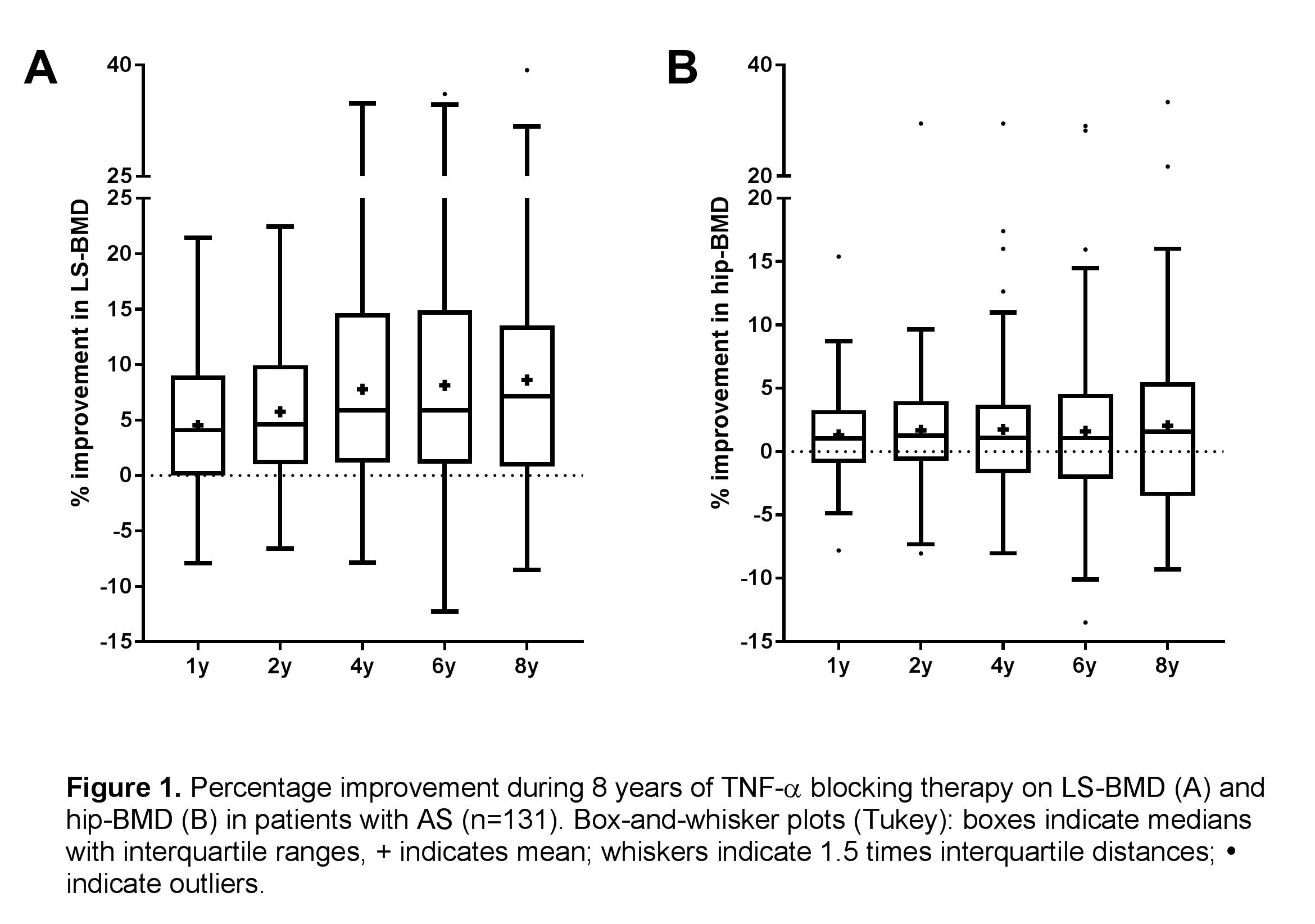Session Information
Date: Sunday, November 8, 2020
Title: Spondyloarthritis Including Psoriatic Arthritis – Treatment Poster III
Session Type: Poster Session C
Session Time: 9:00AM-11:00AM
Background/Purpose:
Ankylosing spondylitis (AS) is a chronic inflammatory disease that mainly affects the axial skeleton. Bone loss reflected by low bone mineral density (BMD) is a common feature of AS and can already be observed at early stages of the disease. A recent cohort study of 135 AS patients reported 7.2% improvement in lumbar spine BMD and 2.2% improvement in hip BMD after 4 years of tumor necrosis factor-alpha (TNF-α) blocking therapy.1 The objective of this study was to assess the effect of 8 years of TNF-α blocking therapy on BMD of the lumbar spine and hip in AS patients.
Methods:
Included in this study were consecutive AS outpatients from the Groningen-Leeuwarden Axial SpA (GLAS) cohort who received TNF-α blocking therapy for at least 8 years. A maximum of one switch to another TNF-α inhibitor was allowed. Patients were excluded when they used bisphosphonates at baseline or during follow-up. BMD of the lumbar spine (anterior-posterior projection L1-L4) (LS-BMD) and hip (total proximal femur) (hip-BMD) was measured at baseline, 1 year, 2 years and then bi-annually using dual-energy X-ray absorptiometry (Hologic QDR Discovery (UMCG) or Hologic QDR Delphi (MCL), Waltman, MA, USA). Z-scores, the number of SD from the normal mean corrected for age and gender, were calculated using the NHANES reference database. Low BMD was defined as lumbar spine and/or hip BMD Z-score ≤1. Generalized estimating equations were used to analyze BMD over time within subjects. Pairwise contrast were used to compare baseline and follow-up visits. P values < 0.05 were considered statistically significant.
Results:
In total, 131 AS patients were included; 73% were male, 83% HLA-B27+, mean age was 41.3 ± 10.8 years, median symptom duration 14 years (IQR 7-24), median CRP levels 13 mg/L (IQR 6-22), and 28% had poor vitamin 25(OH)D3 status (< 50) at baseline. 27% of patients switched to a second TNF-α inhibitor during follow-up and disease activity improved significantly during treatment: mean ASDASCRP 3.8 ± 0.8 at baseline and 2.1 ± 0.9 after 8 years (P< 0.001).
At baseline, low BMD at the lumbar spine and hip was present in 34% and 19% patients, respectively. Both LS-BMD and hip BMD Z-scores were significantly improved during TNF-α blocking therapy at all follow-up visits compared to baseline. Significant improvement compared to the previous time point was found up to and including 4 years for the lumbar spine and up to and including 2 years for the hip. Thereafter, flattening of improvement was observed. Median percentage of improvement in absolute BMD after 8 years of TNF-α blocking therapy compared to baseline was 7.1% (IQR 0.8-13.5) for the lumbar spine and 1.6% (IQR -3.5-5.5) for the hip (Figure 1).
Conclusion:
In AS patients with established disease, both lumbar spine and hip BMD improved significantly at group level during 8 years of TNF-α blocking therapy. This effect was most pronounced in the lumbar spine, which corresponds to the disease process in AS. Main improvements in lumbar spine BMD were observed during the first 4 years of treatment.
References:
1. Beek et al. J Bone Miner Res. 2019; jun;34(6):1041-8
To cite this abstract in AMA style:
Siderius M, Wink F, Spoorenberg A, Arends S. The Effect of 8 Years of TNF-α Blocking Therapy on Bone Mineral Density in Patients with Ankylosing Spondylitis [abstract]. Arthritis Rheumatol. 2020; 72 (suppl 10). https://acrabstracts.org/abstract/the-effect-of-8-years-of-tnf-%ce%b1-blocking-therapy-on-bone-mineral-density-in-patients-with-ankylosing-spondylitis/. Accessed .« Back to ACR Convergence 2020
ACR Meeting Abstracts - https://acrabstracts.org/abstract/the-effect-of-8-years-of-tnf-%ce%b1-blocking-therapy-on-bone-mineral-density-in-patients-with-ankylosing-spondylitis/

